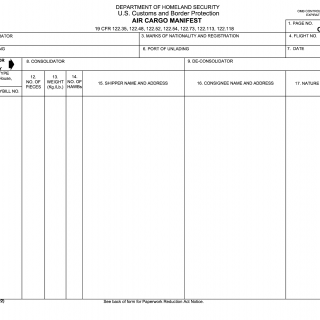CBP Form 7509. Air Cargo Manifest
CBP Form 7509, also known as the Air Cargo Manifest, is a critical document required by the US Customs and Border Protection agency for all air cargo shipments entering or leaving the United States.
The main purpose of the form is to provide information about the cargo being transported, including details such as the shipper, consignee, and the contents of the shipment. The form is used to ensure that all cargo is properly accounted for and to prevent the entry of any illegal or prohibited goods into the country.
The form consists of several parts, including the shipper's information, the consignee's information, the flight details, and a detailed description of the cargo being transported. Important fields to consider when completing the form include the commodity code, the weight and volume of the cargo, and any applicable tariffs or taxes.
The parties involved in the form include the shipper, the consignee, the airline carrier, and the US Customs and Border Protection agency. It is important to consider the accuracy and completeness of the information provided on the form, as any errors or omissions can result in delays or penalties.
When completing the form, data such as the shipper's name and address, the consignee's name and address, and a detailed description of the cargo being transported are required. Additionally, any applicable documentation, such as commercial invoices or bills of lading, must be attached to the form.
Strengths of the form include its ability to ensure the proper accounting of all air cargo shipments entering or leaving the United States, while weaknesses include the potential for errors or omissions that can result in delays or penalties. Opportunities for improvement include the use of electronic manifests to streamline the process, while threats include the potential for security breaches or the transport of illegal or prohibited goods.
Related forms include the CBP Form 3461, which is used for the entry of goods into the United States, and the CBP Form 7512, which is used for the transportation of goods in-bond. Analogues include the International Air Transport Association (IATA) Cargo-XML messaging standard, which provides a standardized format for electronic air cargo messaging.
The form is critical for the future of the participants, as it ensures compliance with US Customs and Border Protection regulations and helps to prevent the entry of illegal or prohibited goods into the country. The form is submitted to the US Customs and Border Protection agency at the port of entry or departure and is stored in their database for future reference.

